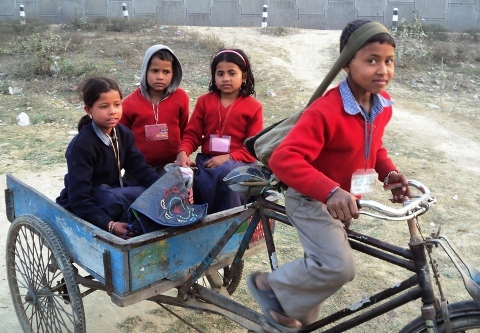The latest Union Budget infamously reduced the total allocation to education by around 2%. This was somewhat surprising given that the BJP had promised to allocate 6% towards education as recommended by the Kothari Commission (1964-66). This would have been an increase from the 4.6% of the last UPA budget.
However, there were several positive developments -- the expenditure on secondary and tertiary education was increased by a whopping 22%. The department of Higher Education was allotted Rs 26,855.26 crore, a significant improvement from last year's revised estimates of Rs 23,700 crore. But what was even more heartening was the increased focus on skilled labour. Depending on which survey you look at, as little as 2-7% of the Indian workforce is in the organised sector. Increasing the level of vocational training will help workers from the informal sector transition into formalised labour where they can better contribute to sectors such as manufacturing.
Image may be NSFW.
Clik here to view.
The term "informal sector" was first introduced in 1972 by the International Labour Organisation and the precise boundaries of its definition have been debated upon since then. The 15th ICLS in Geneva arrived at the following operational definition: "For statistical purposes, the informal sector is regarded as a group of production units which, according to the definitions and classifications provided in the United Nations System of National Accounts (Rev. 4), form part of the household sector as household enterprises or, equivalently, unincorporated enterprises owned by household."
The Indian government has established many commissions and committees to clearly define the informal sector in the Indian context. The most recent of these is the Committee on Unorganised Sector Statistics established by the Ministry of Statistics and Program Implementation. According to the committee's report, the fundamental features of the informal sector in India are: a) the overwhelming number of informal enterprises working out of homes and offices; and b) a workforce that is constantly in flux and is thus, very difficult to measure. The committee goes on to argue that it is in the interest of the government to transform the unorganised sector into an organised one.
Organised labour allows for the provision for a specific number of work hours, provident funds, sick leaves and pension packages. Employees and employers will both benefit from the increased job security as it enables the creation of stable market conditions that make the economy self-sustainable and stronger.
Image may be NSFW.
Clik here to view.
Education plays a big role in this process. The creation of new colleges and the re-organisation of existing ones have demonstrated that the government is aiming to increase its outreach capacity. At the same time, launching the National Skills Mission through the Skills Development and Entrepreneurship Ministry will go a long way in making the 30 million youth population that is near-productive more employable.
Furthermore, skills development will have the largest impact towards employment as it creates jobs from a bottoms-up approach. Given that skills programmes are typically of a shorter duration (2-3 years) than a conventional degree course, they will better equip the youth to meet their immediate monetary needs. The 66th round of National Sample Survey Organisation showed that between 2005 & 2009, 27.7 million new jobs were created but the number of self-employed people decreased by 25.5 million, leading to a net increase of only 2.2 million jobs. Enabling more people to develop expertise in particular sectors will boost entrepreneurship and self-employability. It will also increase the number of people being absorbed in various manufacturing and service industries without the companies having to train them at an additional cost.
Image may be NSFW.
Clik here to view.
Narendra Modi's election campaign prioritised economic growth and better employment to great success. Tapping into the unorganised sector by increasing the number of skilled workers is a positive step towards securing the promised achche din. Registration of labourers to the 'Pandit Deendayal Upadhyay Shramev Jayate Karyakram' will enable the government to reach out to the 42 crore workers in the Construction sector, 86% of which are unskilled and therefore unproductive.
Given that Parliament successfully approved the transition of the coal and insurance ordinances into legislations, such measures (combined with the Make In India program) could lead to massive job creation. As 54% of India's population is below the age of 25, such moves and policy changes have come at the right time. Ultimately, the success of these measures will lie in their implementation, and only time will be the true judge of that.
Written by Prakhar Misra, Teach For India Alumnus & Chanakya Scholar at the Meghnad Desai Academy of Economics.
Applications to the 2016-18 Teach For India Fellowship program are now open. Apply now at http://apply.teachforindia.org/user/register. Application Deadline - 8th December'15
Image may be NSFW.
Clik here to view.![2015-10-20-1445343551-860310-52.png]()
Image may be NSFW.
Clik here to view.![]() Like Us On Facebook |
Like Us On Facebook |
Image may be NSFW.
Clik here to view.![]() Follow Us On Twitter |
Follow Us On Twitter |
Image may be NSFW.
Clik here to view.![]() Contact HuffPost India
Contact HuffPost India
However, there were several positive developments -- the expenditure on secondary and tertiary education was increased by a whopping 22%. The department of Higher Education was allotted Rs 26,855.26 crore, a significant improvement from last year's revised estimates of Rs 23,700 crore. But what was even more heartening was the increased focus on skilled labour. Depending on which survey you look at, as little as 2-7% of the Indian workforce is in the organised sector. Increasing the level of vocational training will help workers from the informal sector transition into formalised labour where they can better contribute to sectors such as manufacturing.
Image may be NSFW.
Clik here to view.

The term "informal sector" was first introduced in 1972 by the International Labour Organisation and the precise boundaries of its definition have been debated upon since then. The 15th ICLS in Geneva arrived at the following operational definition: "For statistical purposes, the informal sector is regarded as a group of production units which, according to the definitions and classifications provided in the United Nations System of National Accounts (Rev. 4), form part of the household sector as household enterprises or, equivalently, unincorporated enterprises owned by household."
The Indian government has established many commissions and committees to clearly define the informal sector in the Indian context. The most recent of these is the Committee on Unorganised Sector Statistics established by the Ministry of Statistics and Program Implementation. According to the committee's report, the fundamental features of the informal sector in India are: a) the overwhelming number of informal enterprises working out of homes and offices; and b) a workforce that is constantly in flux and is thus, very difficult to measure. The committee goes on to argue that it is in the interest of the government to transform the unorganised sector into an organised one.
Organised labour allows for the provision for a specific number of work hours, provident funds, sick leaves and pension packages. Employees and employers will both benefit from the increased job security as it enables the creation of stable market conditions that make the economy self-sustainable and stronger.
Image may be NSFW.
Clik here to view.

Education plays a big role in this process. The creation of new colleges and the re-organisation of existing ones have demonstrated that the government is aiming to increase its outreach capacity. At the same time, launching the National Skills Mission through the Skills Development and Entrepreneurship Ministry will go a long way in making the 30 million youth population that is near-productive more employable.
Furthermore, skills development will have the largest impact towards employment as it creates jobs from a bottoms-up approach. Given that skills programmes are typically of a shorter duration (2-3 years) than a conventional degree course, they will better equip the youth to meet their immediate monetary needs. The 66th round of National Sample Survey Organisation showed that between 2005 & 2009, 27.7 million new jobs were created but the number of self-employed people decreased by 25.5 million, leading to a net increase of only 2.2 million jobs. Enabling more people to develop expertise in particular sectors will boost entrepreneurship and self-employability. It will also increase the number of people being absorbed in various manufacturing and service industries without the companies having to train them at an additional cost.
Image may be NSFW.
Clik here to view.

Narendra Modi's election campaign prioritised economic growth and better employment to great success. Tapping into the unorganised sector by increasing the number of skilled workers is a positive step towards securing the promised achche din. Registration of labourers to the 'Pandit Deendayal Upadhyay Shramev Jayate Karyakram' will enable the government to reach out to the 42 crore workers in the Construction sector, 86% of which are unskilled and therefore unproductive.
Given that Parliament successfully approved the transition of the coal and insurance ordinances into legislations, such measures (combined with the Make In India program) could lead to massive job creation. As 54% of India's population is below the age of 25, such moves and policy changes have come at the right time. Ultimately, the success of these measures will lie in their implementation, and only time will be the true judge of that.
Written by Prakhar Misra, Teach For India Alumnus & Chanakya Scholar at the Meghnad Desai Academy of Economics.
Applications to the 2016-18 Teach For India Fellowship program are now open. Apply now at http://apply.teachforindia.org/user/register. Application Deadline - 8th December'15
Image may be NSFW.
Clik here to view.

Image may be NSFW.
Clik here to view.
 Like Us On Facebook |
Like Us On Facebook | Image may be NSFW.
Clik here to view.
 Follow Us On Twitter |
Follow Us On Twitter | Image may be NSFW.
Clik here to view.